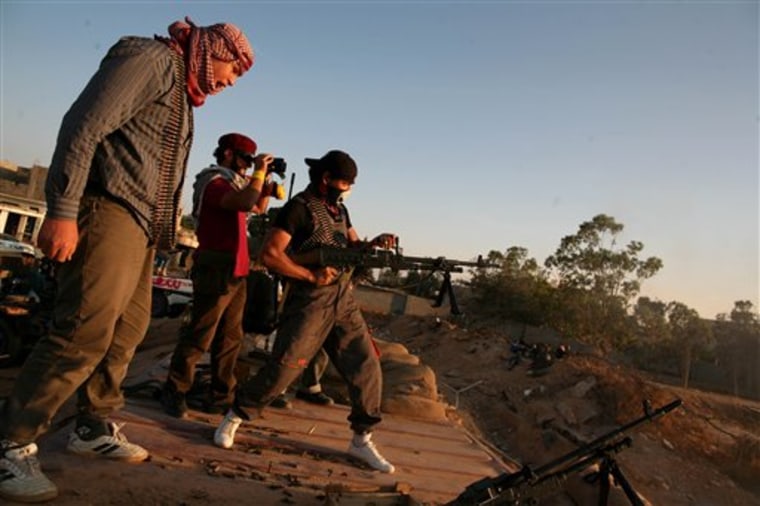Fighting on their home turf, Misrata's rebels overcame the heavier firepower of Moammar Gadhafi's forces in punishing street battles that expelled them from the western Libyan city. They now face what could prove a far tougher task — defeating a better-armed military in open terrain.
Opposition forces have expanded the territory under their control over the past month, pushing the front lines 15 miles (25 kilometers) in a sweeping arc around the port city and putting Misrata out of range of Gadhafi's heavy weapons.
But the rebels face new challenges as they shift from street battles to fighting in the olive groves, wheat fields and sandy desert that surround the city.
"It is a different scenario. Now it's more difficult," said Salaheldin Badi, a senior rebel commander. "It demands more equipment. Supplies, logistics and communications are an issue."
Misrata's rebels, around 3,000 active fighters in all, according to Badi, are now spread over three fronts outside the city: to the west, south, and east. For now, the rebels say they are content to hold onto the territory they've won, allowing some breathing room to civilians in Misrata, on the eastern and southern fronts.
But the western front, focused along the main road to the capital, Tripoli, 125 miles (200 kilometers) away, is simmering. In the farmland and dusty tree-lined fields around the hamlet of Dafinyah, rebels and Gadhafi forces engage in daily firefights, using heavy machine guns and mortars.
In a daylong gunbattle on Thursday, bullets zipped overhead as rebels fired AK-47s and rocket-propelled grenades behind sandy embankments at government troops attacking through the olive groves. Three rebels were killed and 20 wounded in the fighting.
The rebels in Dafinyah have dug in and are using a winning tactic from their battles for the city center, blocking the main road west with shipping containers and sand berms, and coordinating their defense behind them.
They've also dug 12-foot trenches through main roads and access points to fend off tanks, and set up strings of small outposts along the front lines, using two-way radios to communicate.
Wary of overextending, the rebels have held tight at the current line for two weeks. But the goal ahead, commanders say, is Zliten, 30 miles (50 kilometers) west of Misrata.
Badi and other senior opposition military leaders say they're hesitant to push hard for the city. Instead, they want to allow the opposition in Zliten to rise up and secure the city themselves before advancing.
"Revolutionary forces in Zliten are determined and prepared to cleanse Zliten of Gadhafi forces," said Misrata military spokesman Ibrahim Beatelmal. He estimated there are more than 2,000 government troops in Zliten, but declined to comment on the number of opposition fighters.
He said he expects "good news from Zliten" in the next few days, but did not elaborate, and it was not immediately possible to verify whether fighting was taking place inside the city.
The main problem for the rebels on all three of Misrata's fronts, according to fighters and commanders, is a familiar one: a lack of ammunition and arms, especially heavier weapons.
For weeks rebels have had to make do with the guns they've captured from Gadhafi's forces, homemade weapons they've outfitted themselves and the trickle of ammunition and arms that have come in on fishing boats from Benghazi, the de facto rebel capital in the east.
In street fighting, the rebels could improvise with hit-and-run tactics using machine guns and gasoline bombs. Not so in the countryside. Now, long-range weapons like Grad rockets and mortars are in demand.
"There are shortages of heavy weapons," said Mustafa al-Wakshi, a 24-year-old fighter in Dafniyah. "We even have some issues with ammunition for AK-47s."
Khalil al-Shibli, a former colonel in the Libyan army now leading a reconnaissance unit on Misrata's southern front, said 10 of his 30 men don't even have guns.
"We have more people than weapons," al-Shibli said. He estimated that the rebels have only 30 percent of the arms they need. "Heavy weapons are the most important."
A lack of longer-range arms has plagued rebels in eastern Libya, who have struggled against Gadhafi forces in the vast stretches of open desert. Government troops there used the longer reach of their Grad rockets, mortars and artillery to pound opposition fighters, who have fled in the face of such barrages.
Commanders in Misrata say they've learned from the mistakes of rebels in the east.
"We are different. They went to war in open land, and their advance wasn't planned," al-Shibli said over coffee in a tent nestled in the sand dunes on Misrata's southern front as he hashed out positions with another rebel commander over a Google Earth map on a laptop computer.
His group of around 30 fighters makes forays into the flatlands south of its base, a smattering of tents, water tanks and pickup trucks on high ground overlooking the surrounding plains.
"We're not planning to go after Gadhafi's forces," he said. "We have a defensive line here to prevent him from getting into Misrata."
They are taking their time, weighing each move.
